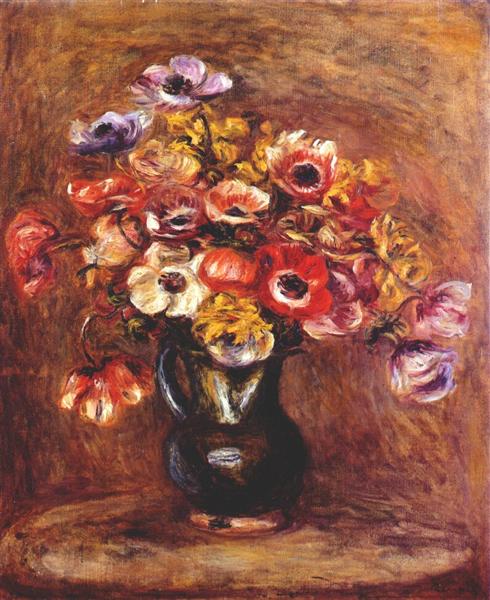Description
Pierre-Auguste Renoir's work "Anemones", made in 1898, is among the most vibrant and sensory expressions of floral art in impressionist painting. Renoir, a master In the representation of color and light, use these qualities to explore the subtleties and beauty of the anemones in an arrangement that is, at the same time, naturally and carefully designed. In the context of his work, this work reflects his continuous interest in the capture of everyday life and nature, recurring issues throughout his career.
The composition of "anemones" is a testimony of the domain of renewing on the mixture of colors and its ability to create a light effect. The flowers are arranged in a way that seem to flow towards each other, capturing the energy found in nature. White, pink and purple tones predominate, which are intertwined and combined in a chromatic symphony that suggests both fragility and vitality. With a soft background that seems to blur, renew focuses on the viewer's attention on the color tide that constitutes the bouquet.
Unlike many works by his contemporary Claude Monet, who focused on landscapes and changing light, renovated immersed himself in the intimacy of the object, making "anemones" a study on the shape and color instead of a landscape. The flowers, although in an artificial arrangement, seem to possess their own soul, showing the artist's mastery to make the inanimate come life. There are no characters present in the painting, which accentuates the unique approach in the beauty of the bouquet; This choice reinforces the symbolism of pure nature as the focus of its attention.
It is interesting to note that, at this time of his career, Renoir had begun to move away from the human figures that characterized his previous work. In his search for simplicity and essential beauty, Renoir dedicated considerable time to exploring issues of nature and the use of light to manipulate color perception. "Anemones" can be considered a precursor to his subsequent work, where the use of color and shape becomes even more evident, inspiring generations of artists to follow their steps.
The work is part of the spirit of the end of the 19th century, a period marked by the desire to capture the ephemeral beauty of life and nature. Like the contemporaries of renewing, as Gogh or Monet, he also explores the idea of immediacy and visual experience, but does so from a perspective that highlights the sensuality of the form on the light of the landscape.
In conclusion, "anemones" is not only a work that represents the technical mastery and the sensitivity of renewing towards color and composition, but also offers a window to the evolution of its artistic style in the context of printing. Painting remains a magnificent example of how flowers, rather than a simple aesthetic object, can become a powerful statement of beauty and emotion. The legacy of renewing in floral painting continues to inspire and influence contemporary artists, reaffirming their place as one of the great masters of the representation of color and shape.
KUADROS ©, a famous paint on your wall.
Hand-made oil painting reproductions, with the quality of professional artists and the distinctive seal of KUADROS ©.
Reproduction service paintings With a guarantee of satisfaction. If you are not completely satisfied with the replica of your painting, we refund your money 100%.

